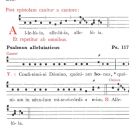Easter Vigil Gospel Acclamation
-
Somehow I never noticed before how odd this 'responsorial' Alleluia is:
Alleluia x3, Give thanks…
Alleluia x3, The right hand…
Alleluia x3, The stone which the builders… Alleluia x3
Gr. Rom. & Gregorian Missal of course have Alleluia [sans jubilus] Confitemini Dominum, i. e. a single verse.
I guess it's just a dress rehearsal for the Sunday morning '2nd Reading', but does anyone know how this really came about?Thanked by 1Elmar -
I do not know but I'll ask in my liturgy course next Saturday.
In any case it is one of the mysterious discrepancies between missal and lectionary, which can only arise because they are different books that aren't updated simultaneously - and an update of one of them isn't necessarily followd by an according change in the other at its following update. Let's call this organic development...
[ceterum censeo : sequentiam appellatur praecedentiam in quarta editione Missalis Romani] -
A bad case of a traditional/modern mash-up. I really don't think the triple Alleluia is called for in the second, third, and fourth iterations, but just a single Alleluia. Or replace the traditional response with a three-iteration Alleluia, such as the Office provides.
-
We've always done the traditional vigil alleluia followed by the verse "comfetemini," and then launched right into a responsorial alleluia during which the altar party charges the thurible, processes to the ambo, etc. Is it incorrect to do both?
-
Typically you do the three Alleluia's first
then Give thanks... then
do the third Alleluia, then
The right hand..., then
do third Alleluia, then
The stone..., then
do for the final time third Alleluia.
This is how it's been done in my years of choir service sing the 1980s
Thanked by 1MarkB -
another option / relevant thread
https://forum.musicasacra.com/forum/discussion/12377/confitemini-domino#Item_5Thanked by 1Richard Mix -
The Graduale Simplex does not offer a complete set of music for the Vigil. It does set the RP as a Responsary. A triple Alleluia, followed by six verses of the psalm Confitemini using the same tone as the Alleluia, the third Alleluia providing the Respond. Where that might be found in the treasury I do not know. (the other verses are on the next page)

 2022-04-05 (2).png387 x 374 - 94K
2022-04-05 (2).png387 x 374 - 94K -
It seems there is a lot of variability here.
In the (Novus) Simplex it is proposed as Alleluia x3 from the cantor, then Alleluia x3 from the omnibus, then responsorially Give thanks/Let Aaron/Let Israel/Let those, with the third Alleluia as the R. The Alleluia is simplexified, but recognizable.
In the (Novus) Missal it is proposed as Alleluia x3 from the priest, "which all repeat”, then responsorially “Psalm 117” with the people responding Alleluia. The verses of Person 117 are not specified in the Missal, and neither is the melody for the response. The melismatic Alleluia x3 is given, together with the inherited tradition of raising the pitch each time. (The rising pitch rubric is not specified in the Simplex.) The “psalmist” can sing the Alleluia instead of the priest, if necessary.
In the (Novus) Gradual, as mentioned ed above, it is proposed just as in the Missal, except that the verse Confitemini (Give thanks) alone is included. The response Alleluia music is not actually specified, although omnes repetunt suggests that its editors want the melismatic Alleluia as the response.
In the (Novus) ordo cantus missae, there is no music specified at all (!). The cantor intones the Alleluia. The verse Give thanks alone is specified, as in the Gradual. Somewhat disingenuously the rubric then says “omitting the Tract” -- which is otherwise mentioned nowhere at all.
As for the (traditional) Roman rite: the melismatic Alleluia is sung by the celebrant x3, with the higher pitch each time, and repeated by the “Chorus” each time. (This rubric is unchanged from 1570 to 1955 to 1962), followed by Give thanks, then by the Tract (aha) which is from psalm 116 two verses (Praise the Lord / For His mercy). It is not Responsorial, of course.
Thanked by 1Elmar -
Andrew_Malton - the Tract is mentioned in the Graduale Triplex, where on p.192 at the end of the verse Confitemini there is a manuscript addition "+Tr. Laudate"
-
Dr Mahrt has either written on the history of the verses of this alleluia, or I heard him speak on it at a colloquium.
-
Just one note: The "Ordo Cantus Missae" is the document upon which the 1974 "Graduale Romanum" is based: so, the OCM says that the Tract is omitted, and thus it is not included in the GR. The MS addition of "+Tr. Laudate" in the Triplex merely indicates that in the MSS of Sankt Gallen that Tract follows the Alleluia; it isn't a rubric for it's inclusion in the Novus Ordo Vigil.
Welcome to the MusicaSacra Forum!
To participate in the discussions on Catholic church music, sign in or register as a forum member, The forum is a project of the Church Music Association of America.
Categories
- All Discussions21,053
- General Music Discussion8,194
- Job Openings190
- Management of Music Programs850
- Choral Matters532
- Church Documents and Rubrics524
- CMAA Notes300
- Events713
- For Newcomers: Read First26
- Sacred Polyphony546
- Hymnody871
- Gregorian Chant: General2,694
- ↳ Graduale Romanum and Liber Usualis367
- ↳ Graduale Simplex60
- ↳ Semiology63
- Vernacular Plainsong695
- Anglican Use and Anglican Chant68
- Organ, Other Instruments and Repertoire433
- New Composition/Works in Progress1,285
- Recordings229
- Music for Hispanic Ministry159
- Music Education: Children211
- Music Education: General222
- News Items245
- Positions Wanted2
- General Discussion: Catholicism738
- Amusements176
- General Discussion1,033
- Opinions117



